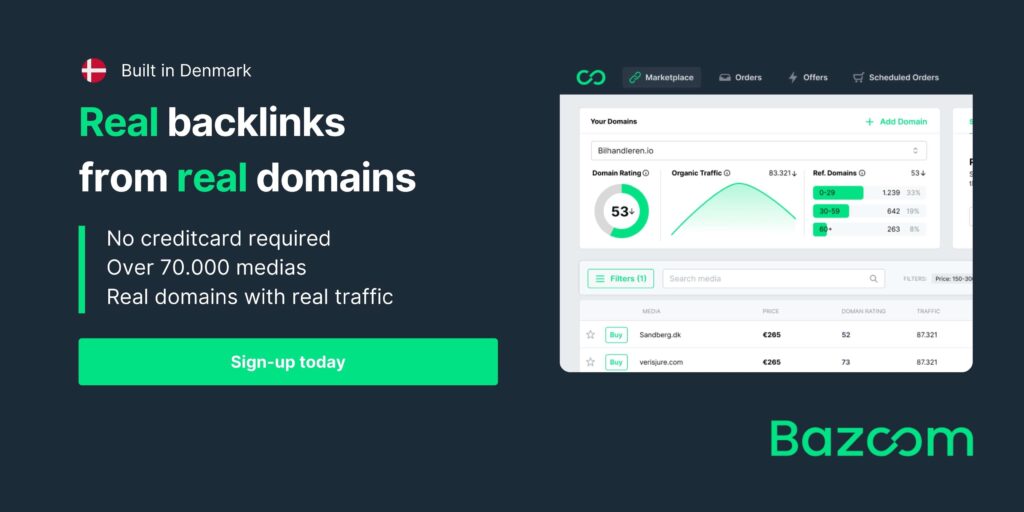
I am often asked about the tools I use. In a perfect world, we would only need to use one tool. Unfortunately, it would take too long to develop a tool that can encompass all functions, so those of us who work in online marketing have to use several different tools.
However, I always stick to the idea that it’s better to use fewer tools. This way, it’s easier for you to maintain an overview—instead of using 50 different tools that you might be “lost” in. Keep it simple!
See if you can stick to a few tools within each area and become extremely good at handling these tools—way to go!
Tools I Couldn’t Live Without
There are many tools for all sorts of challenges in the digital industry. Therefore, I have selected the tools that I use the most below. One can always debate whether you need more tools for each discipline, but that’s not my experience.
You can get very far with just one tool if you spend the time mastering it.
Best SEO Tool – Morningscore
My absolute favorite tool when it comes to SEO is Morningscore. The system can do everything I need. Plus, it’s set up like a game. This means that when I teach my clients, it’s easy for them to understand. This often means they are more likely to succeed with it, unlike more technical tools like Screaming Frog can be.
A few of my favorite features in Morningscore:
- Website analysis – health and technical errors
- Keyword analysis, search volume & rankings
- Competitor analysis
- Reports you can set up
- “Missions” that help you make progress
Popup Tool – Sleeknote
Emails are still the best “driver” for revenue for most businesses. Therefore, it also pays to expand your email list. I’ve tried all kinds of opt-in tools and popup tools over the past 10 years. There are thousands of them, but none make it as simple as Sleeknote. I love their interface.
A few of my favorite features in Sleeknote:
- Guide your users to a specific landing page
- Run a competition and collect emails
- A/B split testing of popups
- Inline popups for blog posts, for example
- Strong analysis tool for optimization
Dashboard Tool – Dashthis
Analysis is one of the most important disciplines when it comes to online marketing. Therefore, there are also a lot of tools for data analysis. Most people are probably familiar with Google Analytics, which is also soon being upgraded to G4. However, Analytics and similar tools can be confusing because they can do so much. I’ve been privileged to grow up with these systems, so I’ve grown with them.
But I often feel that these systems have limitations. That’s why I’ve gone a different route. When I report to my clients, I use one system—Dashthis. Dashthis can pull data from almost any platform. So, for example, I can pull data from Facebook, Instagram, YouTube, Mailchimp, LinkedIn, Google Ads, etc., and create a common dashboard for total performance. I’ve done this for over 100 clients, and it works super well because everyone can relate to it.
A few of my favorite features in Dashthis:
- Combine different data sources
- Easy visual overview without too much confusion
- Direct API integration to most platforms
- Easy to create multiple dashboards for each area of the business
- Solid customer support
CRM Hubspot – HubSpot
My absolute favorite tool when it comes to CRM and marketing automation is HubSpot.
But it’s complex. However, it’s also a system where you can choose to use specific branches of it, and not necessarily everything. I would recommend taking the time for it. And not least, it costs a lot. It’s often used by larger companies that want to scale their setup to the next level.
A few of my favorite features in HubSpot:
- Contact Management and CRM – Provides a clear overview of all your contacts and their interactions.
- Email Marketing and Automation – Allows you to create automated email campaigns and workflows.
- Lead Nurturing and Scoring – Helps identify and prioritize potential customers.
- Analysis and Reporting – Offers in-depth analysis of campaigns and activities, which can be customized and scheduled.
- Integrated Marketing Tools – Everything from blogging, social media to SEO, all in one system.
Shopify – E-commerce #1
There are good systems in most industries. And then there are industries where there is one system better than all the others—combined. In my opinion, Shopify is that system within e-commerce. I have worked with webshops for over 10 years—from Magento to WooCommerce; I have never seen anything perform as well as Shopify—and at the same time, it’s mega intuitive.
A few of my favorite features in Shopify:
- User-friendly Admin Panel – A simple and intuitive interface that makes it easy to manage products, orders, and customers.
- Responsive Design and Themes – A wide selection of professional themes that automatically adapt to different screen sizes.
- Integrated Payment System – Supports a wide range of payment gateways, including Shopify Payments, making it easy to receive payments.
- App Store – A comprehensive library of apps and plugins that can extend the functionality of your webshop.
- SEO and Marketing Tools – Built-in tools for search engine optimization and marketing that help drive traffic to your store.
- Multiple Sales Channels – Ability to sell through different channels such as Facebook, Instagram, Amazon, and physical stores (POS).
- Security and Reliability – Robust infrastructure with high security and uptime, so your store is always available to customers.
WordPress Hosting #1 – Kinsta
Backup and hosting are not the most inspiring when working with digital, though probably one of the most important things. Kinsta solves everything within WordPress hosting. I have worked with web hosting for over 10 years—from traditional shared hosting environments to specialized WordPress hosting solutions. I love Kinsta, so thanks to my developer Mads for pushing me in that direction.
A few of my favorite features in Kinsta:
- User-friendly Dashboard – A simple and intuitive
interface that makes it easy to manage your websites and server settings.
- High Performance – Kinsta uses Google Cloud Platform, ensuring lightning-fast loading times and high reliability.
- Automatic Backups – Daily backups that make it easy to restore your website in case of problems.
- Free SSL and CDN – Included SSL certificate and built-in Content Delivery Network that improve the security and speed of your website.
- 24/7 Support – Expert support available around the clock to help with any technical challenges.
- Scalability – Flexible plans that can scale up or down as needed, making it ideal for growing businesses.
- Security and Reliability – Advanced security measures and constant monitoring ensure your website is always protected and accessible.
- Staging Environment – Ability to create staging environments where you can test changes and updates before they go live.
These features make Kinsta an excellent solution for anyone looking to host their WordPress sites on a fast, secure, and reliable platform.
Linkbuilding Tool – Bazoom
Linkbuilding is still one of the most important disciplines within SEO—rarely has something worked as well as creating quality links. Regardless of how the market thinks linkbuilding is or should be, it works. That’s why I’ve been focusing on placing strategic links for many years to increase the visibility of my own site, and not least my clients’. This is where Bazoom comes into play.
A few of my favorite features in Bazoom:
- Easy overview of media you can buy placements from.
- Easy to follow up on the links you have purchased.
- Globally, easy to expand internationally.
- Access to the hardest edu links and high DR domains.
It’s better to start with fewer tools and get to know them than to take on too many—my experience is that you never finish them anyway.
Email Marketing Tools
- Sleeknote – My favorite program for collecting emails on the site
- MailChimp – easiest email program to get started with
- Klaviyo – advanced email program for advanced email marketing – definitely my favorite
Browser Extensions
I always use Chrome, so these browser extensions are based on Chrome. However, they are (almost) certainly also available for Firefox.
- WhatFont – find out what font the website is using
- Similar Web – I use it for competitor analysis
- Mozbar – SEO bar for optimizing SEO
- Colorpick Eyedropper – find out what color a website is using
- Adblock – block all ads
- Grammarly – corrects English spelling and grammar errors
- Word Count – see how many words are on a page
SEO Tools (Search Engine Optimization)
Since I work a lot with search engine optimization, I naturally also use a few tools that make my daily life easier. Some of these tools are free—or perhaps have a free trial—while others are quite expensive if you need to use them regularly.
- Searchmetrics – used for advanced SEO analyses
- Keywordtool IO – used for keyword analysis
- Ubersuggest – another tool for keyword analysis
- Serp Snippet Tool – see what your meta-tags look like
- Screaming Frog Spider – used for technical SEO crawling
- Google Search Console – used for technical SEO review
- AccuRanker– best tool for tracking keywords
- Ahrefs – probably the most popular tool for SEO optimization
Data Analysis & Tools
All my work is based on data. Therefore, it’s also important for me to have a palette of tools that can help make my daily work just a little easier. I used to primarily use Google Analytics, but after teaming up with Jesper Hvejsel, Excel has become a big part of my daily life with all sorts of exciting functions.
- Google Analytics – foundation for all websites
- Microsoft Excel – used to make sense of large amounts of data
- Visual Website Optimizer – split test and optimize based on data
- Hotjar – record videos of your users and create sharp heat maps
- Zapier – Zapier can connect multiple systems with each other, a must-have!
Content Marketing Tools
Content marketing has become a tool for me to create interesting things that audiences are interested in. It can be anything from videos and blog posts to infographics—and much more.
- Google Analytics – analysis of demographics and landing pages
- Buzzsumo – inspiration for new content
- Excel – analysis of what performs best
WordPress Plugins
Almost all blogs and smaller websites run on the WordPress framework today. It’s super simple—but you can still make it easier for yourself with these plugins. In general, I would also say that if you can learn CSS, you can create a really nice site without having to pay an expensive programmer—again, a big thanks to Rasmus Dencker and Jesper Hvejsel for challenging me on this.
- YOAST SEO – get your SEO rankings in order
- Fastest Cache – optimizes your website so it becomes super fast
- Easy Social Share Buttons – the best social buttons for WordPress
- Instapage – create the coolest landing pages
- Kraken IO – optimize your images so they don’t take up so much space
Social Media & Tools
Social media has always been a big part of my strategy—it’s about creativity, and I’m a big fan of that! Therefore, I also try to use a few tools that can make this aspect of my work life easier and contribute with good ideas on how to create even more creativity.
- Facebook Power Editor – system for Facebook marketing
- Facebook Debugger – check post appearance on Facebook
- Fiverr – small creative ideas from 5 dollars!
- BufferApp – best tool for queuing posts
- Canva – quickly create graphics without Photoshop and technical skills
- Socialblade – quickly overview your progress on social media
AI & Artificial Intelligence Tools
In recent years, AI and artificial intelligence have really gained traction, not least in the marketing world. Therefore, it’s also appropriate to mention a few of the AI tools that I use the most in this category. These tools can be very technical, and it takes quite a while to learn how to communicate with them. So, take your time if you choose to explore them.
- ChatGPT – the most recognized tool in AI
- Beautiful.ai – create presentations via AI
- Midjourney5 – create images via AI
- Image Bing Creator – create images via AI
Podcast Tools
When it comes to producing podcasts, it’s essential to have the right tools at hand.
I have tried several tools and found the best ones to ensure high quality and efficiency in my workflow.
- Audacity – Free and user-friendly audio editing software with extensive editing features.
- Anchor – Easy hosting and distribution to platforms like Spotify and Apple Podcasts.
- Blue Yeti – Reliable microphone with excellent sound quality.
- Adobe Audition – Advanced audio editing for professional production.
- Podbean – Efficient podcast hosting and analytics tools.
- Audiojungle – Find the perfect jingle for your podcast.
- Fiverr – Get unique jingles and logos produced by freelancers.
- Canva – Design tool for logos and marketing.
- Headliner – Highlight key points from your podcast visually.
- Calendly – Easily schedule interviews with your guests.
- Auphonic – AI-based sound enhancement for your episodes.
- Chartable – Analytics tool to track your podcast’s performance.
- Zencastr – Record podcast interviews online.
Conversion Rate Optimization (CRO) Tools
Conversion Rate Optimization (CRO) is an important discipline within digital marketing, focusing on increasing the percentage of visitors who take a desired action on your website, such as filling out a form, signing up for a newsletter, or making a purchase. CRO is about understanding and improving the user experience by analyzing user behavior, testing different elements on your pages, and implementing data-driven changes.
Effective CRO can lead to higher conversion rates, greater customer satisfaction, and increased ROI. To help achieve these goals, several powerful tools can make the process simpler and more efficient.
- Optimizely – A/B testing platform to optimize the user experience.
- Unbounce – Build and test landing pages quickly without developers.
- Crazy Egg – Offers heatmaps and user analysis to understand user behavior.
- Convert.com – Comprehensive A/B testing tool with advanced features.
By using these tools, you can continuously improve your website and ensure that you get the most out of your web traffic. Each of these tools offers unique features that can help you identify and implement the changes that will have the greatest positive impact on your conversion rates.
Conclusion
Did I forget some tools that you are passionate about?
Feel free to leave a comment below. There are plenty of good tools out there, and I’ve tested many, but not nearly enough. If you’ve come across a tool you’d like to share—please do! 🙂
—















Comments